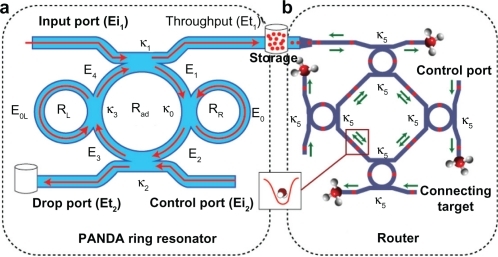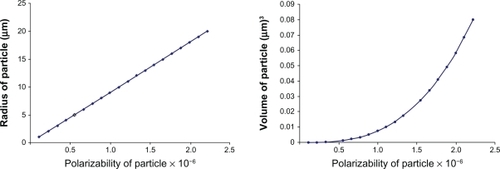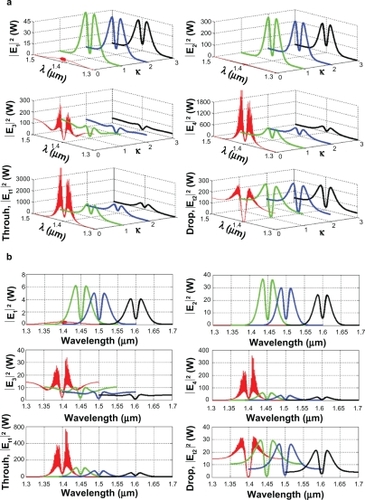 ?Mathematical formulae have been encoded as MathML and are displayed in this HTML version using MathJax in order to improve their display. Uncheck the box to turn MathJax off. This feature requires Javascript. Click on a formula to zoom.
?Mathematical formulae have been encoded as MathML and are displayed in this HTML version using MathJax in order to improve their display. Uncheck the box to turn MathJax off. This feature requires Javascript. Click on a formula to zoom.Abstract
A novel design of molecular buffer for molecule storage and delivery using a PANDA ring resonator is proposed. The optical vortices can be generated and controlled to form the trapping tools in the same way as the optical tweezers. In theory, the trapping force is formed by the combination between the gradient field and scattering photons, which is reviewed. By using the intense optical vortices generated within the PANDA ring resonator, the required molecules can be trapped and moved (transported) dynamically within the wavelength router or network, ie, a molecular buffer. This can be performed within the wavelength router before reaching the required destination. The advantage of the proposed system is that a transmitter and receiver can be formed within the same system, which is available for molecule storage and transportation.
Introduction
Optical buffers are recognized as essential components in wavelength routers, in which the packets of data can be stored for resolving packet contention problems and also delay the outgoing packets.Citation1,Citation2 In practice, the optical router patents have been proposed and recorded,Citation3–Citation5 which can be useful for various applications. Recently, the promising techniques of microscopic volume trapping and transportation within the add/drop multiplexer have been reported in both theoryCitation6 and experiment,Citation7 respectively, in which the transporter is known as an optical tweezer. Here, the optical tweezer generation technique has become a powerful tool for the manipulation of micrometer-sized particles. To date, the usefulness of static tweezers is well recognized. Moreover, the use of dynamic tweezers is now also understood in practical works.Citation8–Citation10 Schulz et alCitation11 have shown that the transfer of trapped atoms between two optical potentials can be performed. In principle, optical tweezers use forces exerted by intensity gradients in the strongly focused beams of light to trap and move the microscopic volumes of matters, in which the other combination of force is induced by the interaction between photons, which is caused by photon scattering effects. In application, the field intensity can be adjusted and tuned, in which the desired gradient field and scattering force can form the suitable trapping force. Hence, the appropriate force can be configured for the transmitter/receiver, which can perform the long distance microscopic transportation.
In this paper, dynamic optical tweezers/vortices are generated using a dark soliton, bright soliton, and Gaussian pulse propagating within an add/drop optical multiplexer incorporating two nanoring resonators (PANDA ring resonator). The dynamic behaviors of solitons and Gaussian pulses are well described by Tasakorn et al.Citation12 By using the proposed system, the transceiver can be integrated and performed by using a single device. Here, the use of the transceiver to form the transportation of microscopic volumes of matter, especiallyCitation13 for molecule transportation in liquid core waveguide,Citation14,Citation15 drug delivery, and DNA transportation, in which the buffer is needed before reaching the required destination.
Theory
In operation, the trapping forces are exerted by the intensity gradients in the strongly focused beams of light to trap and move the microscopic volumes of matters, in which the optical forces are customarily defined by the relationship:Citation16
Here Q is a dimensionless efficiency, nm is the refractive index of the suspending medium, c is the speed of light, and P is the incident laser power, measured at the specimen. Q represents the fraction of power utilized to exert force. For plane wave incidences on a perfectly absorbing particle, Q is equal to 1. To achieve stable trapping, the radiation pressure must create a stable, three-dimensional equilibrium. Because biological specimens are usually contained in aqueous media, the dependence of F on nm can rarely be exploited to achieve higher trapping forces. Increasing the laser power is possible, but only over a limited range due to the possibility of optical damage. Q itself is therefore the main determinant of trapping force. It depends upon the numerical aperture (NA), laser wavelength, light polarization state, laser mode structure, relative index of refraction, and the geometry of the particle.
Furthermore, in the Rayleigh regime, trapping forces decompose naturally into two components. Since, in this limit, the electromagnetic field is uniform across the dielectric, particles can be treated as induced point dipoles. The scattering force is given by:Citation16
Here σis the scattering cross section of a Rayleigh sphere with radius r. 〈S〉 is the time averaged Poynting vector, n is the index of refraction of the particle, m = n/nm is the relative index, and k = 2πnm/λ is the wave number of the light. The scattering force is proportional to the energy flux and points along the direction of the propagation of the incident light. The gradient field (Fgrad) is the Lorentz force acting on the dipole induced by the light field. It is given by:Citation16
In our proposal, the trapping force is formed by using a dark soliton, in which the valley of the dark soliton is generated and controlled within the PANDA ring resonator by the control port signals. In this paper, we used the same theory of optical trapping and ring resonator, in which the simulation results and applications are differed from the previous work.Citation18
From , the output field (Et1) at the through port is given by:Citation19
| A | = |
|
| B | = |
|
| C | = |
|
| D | = |
|
| F | = |
|
Figure 1 Schematic diagram of a buffer system, where (a) a PANDA ring resonator, (b) a wavelength router where Radd is the add/drop filter radius and RR and RL are the right and left ring resonator radii, respectively.

Here, Et and Ed represent the optical fields of the through port and drop ports, respectively. β = kneff is the propagation constant, neff is the effective refractive index of the waveguide, and the circumference of the ring is L = 2πR, where R is the radius of the ring. κ1 and κ2 are the coupling coefficients of the add/drop filters, kn = 2π/λ is the wave propagation number for in a vacuum, and the waveguide (ring resonator) loss is α = 0.5 dBmm−1. The fractional coupler intensity loss is γ = 0.1. In the case of the add/drop device, the nonlinear refractive index does not affect the system, therefore, it is neglected. The electric fields E0 and E0L are the field circulated within the nanoring at the right and left side of add/drop optical filter.
The power output (Pt1) at through port is written as:
The output field (Et2)at drop port is expressed as:Citation19
| X | = |
|
| Y = | = |
|
The power output (Pt2) at drop port is:
In operation, the optical tweezers can be trapped, transported, and stored within the PANDA ring resonator and wavelength router, which can be used to form the microscopic volume (molecule) transportation and drug delivery via the waveguide,Citation18 in which the manipulation of trapped microscopic volumes within the optical tweezers has been reported.
Molecular buffer
Molecular buffers are devices that can be used to store or delay atoms/molecules for a period of time (see ), where light intensity and velocity can also be controlled, which was described by Rosenberry et alCitation20 and Lignie and Woerdman,Citation21 available for medical application. Molecular buffers are a new device, which are operated in the same way as gas buffers.Citation22 The polarizability of the particle is calculated by using equation (Equation5(5) ), in this case, we assume that the sphere particle is polystyrene (n = 1.5894) and the liquid medium is water (n = 1.33), and the optical power which is required to trap particles of a certain size/polarizibility is 9.1W, which is the slope as shown in .
Figure 3 Graph of optical power which is required to trap the particle of a certain size/polarizability.

In simulation, the bright soliton with center wavelength at 1.50 μm, peak power 2W, pulse 35fs is input into the system via the input port, and the coupling coefficients are given as κ0 = 0.5, κ1 = 0.35, κ2 = 0.1, and κ3 = 0.35, respectively. The ring radii are Radd = 10 and 30 μm, RR = 50 and 100 nm, and RL = 50 and 100 nm, respectively. To date, the evidence of a practical device with a radius of 30 nm has been reported by Piyatamrong et al.Citation19 Aeff are 0.50, 0.25, and 0.25 μm2. In this case, the dynamic tweezers (gradient fields) can be in the form of bright solitons, Gaussian pulses, and dark solitons, which can be used to trap the required microscopic volume. There are four different center wavelengths of tweezers generated; the dynamical movements are seen in , where (a) |E1|2, (b) |E2|2, (c) |E3|2, (d) |E4|2, (e) through port, and (f) drop port signals, where in this case all microscopic volumes are received by the drop port. In practice, the fabrication parameters which can be easily controlled are the ring resonator radii instead of the coupling constants.
Figure 4 Result of the dynamic tweezers within the buffer with different (a) wavelengths and (b) coupling constants, where Radd = 10 μm, RR = RL = 100 nm.

The important aspect of the result is that the tunable tweezers can be obtained by tuning (controlling) the add (control) port input signal, in which the required amount of microscopic volume (atom/photon/molecule) can be obtained and seen at the drop/through ports, otherwise they propagate within a PANDA ring before collapsing/decaying into the waveguide. More results of the optical tweezers generated within the PANDA ring are shown in , where in this case, the bright soliton is used as the control port signal to obtain the tunable results. The output optical tweezers of the through and drop ports with different coupling constants are as shown in , while the different wavelength results are as shown in , which can be performed by the selected targets. In application, the trapped microscopic volumes (molecules) can move into the wavelength router via the through port, while the retrieved microscopic volumes are received via the drop port (connecting target). The advantage of the proposed system is that the transmitter and receiver can be fabricated on-chip and alternatively operated by a single device.
Figure 5 Result of the dynamic tweezers within the buffer with different (a) coupling constants and (b) wavelengths, where Radd = 30 μm, RR = RL = 50 nm.

The magnitude of the optical trapping force is the pico Newton, which depends upon the relative refractive index of particle, which was given by Kumar et al.Citation23 The particle radius was given by Hu et al,Citation24 Fischer and Sørensen,Citation25 and Nieminen et al,Citation26 which is located in the cavity. It decreases with a reduction in refractive indices compared to the host medium.
Conclusion
We have proposed a new system that can be used to trap (delay) and transport molecules into an optical waveguide by using optical tweezers, which can be used for drug storage and as a delivery system. By utilizing the reasonable dark soliton input power, the dynamic tweezers can be controlled and stored (delayed) within the system before reaching the final destination. Tweezer amplification is also available by using the nanoring resonators, in which the signals can be modulated via the control port as shown in . In conclusion, we have shown that the use of a transceiver for long distance microscopic volume by using the proposed system, in which the drug delivery or molecular communication can be performed via the wavelength router to the required (connecting) targets. However, the problems of large microscopic volume and neutral matter may cause a problem, in which the pursuit of new guide pipes and media,Citation27 for instance, nano tubes and specific gases, will be the issue of investigation.
Acknowledgements
We would like to thank the Institute of Advanced Photonics Science, Enabling Science and Nanotechnology (ESciNano) Research Alliance, UniversitiTeknologi Malaysia (UTM), and King Mongkut’s Institute of Technology (KMITL), Thailand for the support in providing the research facilities. This research work has been supported by the Ministry of Higher Education (MOHE), FRGS-grant 78452.
One of the authors (N Suwanpayak) would like to acknowledge King Mongkut’s Institute of Technology Ladkrabang, Bangkok (KMITL), Thailand for partial support in higher education at KMITL, Thailand.
Disclosure
The authors report no conflicts of interest in this work.
References
- ChengMWuCHiltunenJWangYWangQMyllyläRA variable delay optical buffer based on nonlinear polarization rotation in semiconductor optical amplifierIEEE Photon Technol Lett2009212418851887
- LiuJLeeTTJiangXHoriguchiSBlocking and delay analysis of single wavelength optical buffer with general packet size distributionJ Lightwave Technol2009278955966
- DragoneCP InventorImproved waveguide grating optical router suitable for CWDM United States patent US2009035253392009
- HamBS InventorDelayed optical router/switch United States patent US201002327929162010
- OguchiKTeradaSHanawaM InventorsOptical network system, optical router, fault recovery method of optical network, and program Japanese patent JP20100630093182010
- PiyatamrongBKulsiriratKMitathaSTYupapinPPDynamic potential well generation and control using double resonators incorporating in an add/drop filterMod PhysLett B2010243230713082
- CaiHPoonAOptical manipulation and transport of microparticle on silicon nitride microring resonator-based add-drop devicesOpt Lett201035172855285720808347
- AshkinADziedzicJMBjorkholmJEChuSObservation of a single-beam gradient force optical trap for dielectric particlesOpt Lett198611528829019730608
- EgashiraKTerasakiAKondowTPhoton-trap spectroscopy applied to molecules adsorbed on a solid surface: probing with a standing wave versus a propagating waveApp Opt201049711511157
- KachynskiAVKuzminANPudavarHEKaputaDSCartwrightANPrasadPNMeasurement of optical trapping forces by use of the two-photon-excited fluorescence of microspheresOpt Lett200328232288229014680158
- SchulzMCrepazHSchmidt-KalerFEschnerJBlattRTransfer of trapped atoms between two optical tweezer potentialsJ Mod Opt2007541116191626
- TasakornMTeekaCJomtarakRYupapinPPMultitweezers generation control within a nanoring resonator systemOpt Eng.2010497075002
- NeumanKBlockSMOptical trappingRev Sci Instrum20047592787280916878180
- ParkinSJKnönerGNieminenTAHeckenbergNRDunlopHRPicoliterviscometry using optically rotated particlesPhys Rev E200776415071512
- WolfeDBConroyRSGarsteckPDynamic control of liquid-core liquid-cladding optical waveguidesProc Natl Acad Sci2004101342434243814983027
- SvobodaKBlockSMBiological applications of optical forcesAnnu Rev Biophys Biomol Struct1994232472857919782
- ZhuJOzdemirSKXiaoYFLiLHeLChenDROn-chip single nanoparticle detection and sizing by mode splitting in an ultrahigh-QmicroresonatorNature Photon201044649
- SuwanpayakNJalilMATeekaTAliJYupapinPPOptical vortices generated by a PANDA ring resonator for drug trapping and delivery applicationsBio Med Opt Express201121159168
- PiyatamrongBKulsiriratKTechitdheeraWMitathaSYupapinPPDynamic potential well generation and control using double resonators incorporating in an add/drop filterMod Phys Lett B2010243230713082
- RosenberryMAReyesJPTupaDGayTJRadiation trapping in rubidium optical pumping at low buffer-gas pressuresPhys Rev A200775234013407
- LignieMCWoerdmanJPLight-induced drift of Na in molecular buffer gasesJ Phy B: At Mol Opt Phys1990233417426
- WaggonerPSPalmerJSAntonovVNWeaverJHMetal nanostructure growth on molecular buffer layers of CO2Surf Sci20055961–31220
- KumarRShakherCMehtacDS3D Multiple optical trapping of Au-nanoparticles and prokaryote E. coli using intra-cavity generated non circular beam of inhomogeneous intensityLaser Phys201020615141524
- HuJLinSKimerlingLCCrozierKOptical trapping of dielectric nanoparticles in resonant cavitiesPhys Rev A201082538193826
- FischerMSørensenKBCalibration of trapping force and response function of optical tweezers in viscoelasticJ Opt A: Pure Appl Opt200798239250
- NieminenTADunlopHRHeckenbergNRCalculation and optical measurement of laser trapping forces on non-spherical particlesJ Quant Spectr Rad Transf2001704–6627637
- AshkinAOptical trapping and manipulation of neutral particles using lasersProc Natl Acad Sci19979410485348609144154
